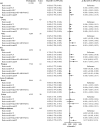Predictive value of 8-year blood pressure measures in intracerebral haemorrhage risk over 5 years
- PMID: 38629743
- PMCID: PMC7616516
- DOI: 10.1093/eurjpc/zwae147
Predictive value of 8-year blood pressure measures in intracerebral haemorrhage risk over 5 years
Abstract
Aims: The relationships between long-term blood pressure (BP) measures and intracerebral haemorrhage (ICH), as well as their predictive ability on ICH, are unclear. In this study, we aim to investigate the independent associations of multiple BP measures with subsequent 5-year ICH risk, as well as the incremental value of these measures over a single-point BP measurement in ICH risk prediction.
Methods and results: We included 12 398 participants from the China Kadoorie Biobank (CKB) who completed three surveys every 4-5 years. The following long-term BP measures were calculated: mean, minimum, maximum, standard deviation, coefficient of variation, average real variability, and cumulative BP exposure (cumBP). Cox proportional hazard models were used to examine the associations between these measures and ICH. The potential incremental value of these measures in ICH risk prediction was assessed using Harrell's C statistics, continuous net reclassification improvement (cNRI), and relative integrated discrimination improvement (rIDI). The hazard ratios (95% confidence intervals) of incident ICH associated with per standard deviation increase in cumulative systolic BP and cumulative diastolic BP were 1.62 (1.25-2.10) and 1.59 (1.23-2.07), respectively. When cumBP was added to the conventional 5-year ICH risk prediction model, the C-statistic change was 0.009 (-0.001, 0.019), the cNRI was 0.267 (0.070-0.464), and the rIDI was 18.2% (5.8-30.7%). Further subgroup analyses revealed a consistent increase in cNRI and rIDI in men, rural residents, and participants without diabetes. Other long-term BP measures showed no statistically significant associations with incident ICH and generally did not improve model performance.
Conclusion: The nearly 10-year cumBP was positively associated with an increased 5-year risk of ICH and could significantly improve risk reclassification for the ICH risk prediction model that included single-point BP measurement.
Keywords: Blood pressure variability; Cumulative blood pressure; Incremental value; Intracerebral haemorrhage; Long term; Risk prediction.
Plain language summary
This prospective cohort study of Chinese adults investigated the independent associations of multiple blood pressure (BP) measures with subsequent 5-year intracerebral haemorrhage (ICH) risk, as well as the incremental value of these measures over a single-point BP measurement in ICH risk prediction.The cumulative BP exposure (cumBP) was positively associated with subsequent 5-year risk of ICH, independent of the recent single-point systolic BP and diastolic BP levels.The cumBP could improve the risk reclassification of the conventional 5-year ICH risk prediction model that included single-point BP measurement for all participants, as well as for men, rural residents, and participants without diabetes.
© The Author(s) 2024. Published by Oxford University Press on behalf of the European Society of Cardiology.
Conflict of interest statement
Conflict of interest: none declared.
Figures


Comment in
-
High blood pressure and intracerebral haemorrhage: a recognized risk factor with new knowledge.Eur J Prev Cardiol. 2024 Oct 10;31(14):1711-1712. doi: 10.1093/eurjpc/zwae187. Eur J Prev Cardiol. 2024. PMID: 38833583 No abstract available.
References
-
- Gil-Garcia C-A, Flores-Alvarez E, Cebrian-Garcia R, Mendoza-Lopez A-C, Gonzalez-Hermosillo L-M, Garcia-Blanco M-d-C, et al. . Essential topics about the imaging diagnosis and treatment of hemorrhagic stroke: a comprehensive review of the 2022 AHA guidelines. Curr Probl Cardiol 2022;47:101328. - PubMed
-
- O'Donnell MJ, Chin SL, Rangarajan S, Xavier D, Liu L, Zhang H, et al. . Global and regional effects of potentially modifiable risk factors associated with acute stroke in 32 countries (INTERSTROKE): a case-control study. Lancet 2016;388:761–775. - PubMed
MeSH terms
Grants and funding
LinkOut - more resources
Full Text Sources
Research Materials
Miscellaneous

